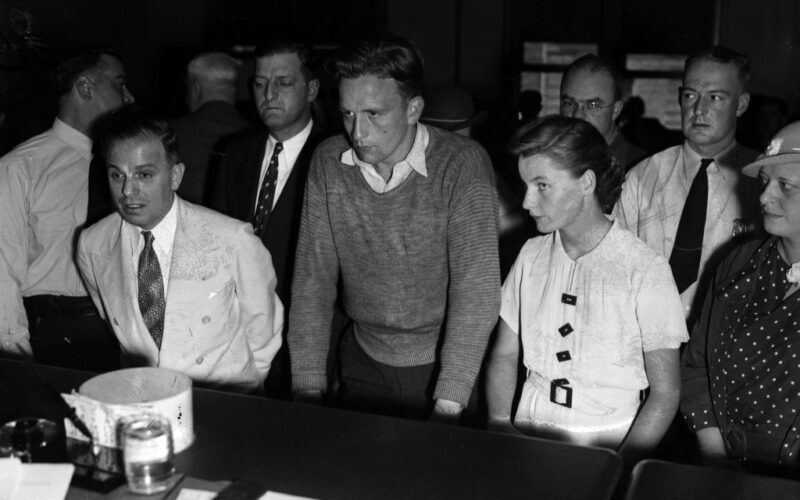There would be no supper for anyone who lived in the Bayonne, N.J., home of Edgar MacKnight and his family on the evening of July 31, 1936.
That’s because the cook, Edgar’s wife Helen, had been murdered in her kitchen as she prepared the meal.
Around 6, Edgar returned from work to find Helen, 47, on the floor in a pool of blood. An ax was next to her body. Six whacks to the head had ended her life.
About an hour earlier, screams brought neighbor Elizabeth Fuery to MacKnight’s backyard. She told police she peered into a window and spotted Gladys, 17, the MacKnight’s spirited eldest daughter, standing in the kitchen.
Fuery asked what the screaming was about. Gladys said Helen cut her finger.
“Go away,” the strawberry-blonde teen snapped and slammed the window shut.
Later, neighbors saw Gladys and her boyfriend, Donald Wightman, 18, roar off in the family’s sedan.
Police had little doubt about the identity of the prime suspects.
“GIRL HACKS MOTHER TO DEATH AS YOUTH HOLDS DOWN VICTIM,” was the wood of the Bayonne Times on Aug. 1, 1936.
A Jersey City sergeant spotted their car speeding by at around 9:45 p.m. and ordered them to stop. The pair leaped out and tried to run but gave up when cops pulled out revolvers and a machine gun.
Gladys, who was wearing a blood-spattered yellow tennis dress, offered her account of the crime. Police said they were amazed by the girl’s attitude.
“She was the coolest thing I ever saw,” said one detective. “All the time she talked, she sat with one leg thrown over the arm of the chair. She smoked one cigarette after another.”

Gladys said Helen was known to be “old fashioned” when it came to matters of the heart. She became furious when she spotted Donald kissing her daughter and went after him with a knife.
Donald grabbed the ax, which Gladys had been using earlier to tack down a rug, and started swinging, she said.
In another room, Donald was offering his confession to police. Details of their accounts matched perfectly—at first.
But later, Donald changed his story. Gladys killed her mother, he told them. All he had done was hold the victim so she couldn’t escape the blows.
His previous confession to the killing, he admitted to detectives, was motivated by a desire to protect the girl he loved.
Six hours into questioning, police brought the lovebirds together.
“Tell the truth, Gladys,” Donald begged. “I told the truth, and you might as well.”

An hour later, Gladys opened up. On the day of the murder, she said she and Donald went to a tavern around 2 p.m. and each had four beers.
After 5, they showed up at the MacKnight home. Gladys told her mother to hurry up and prepare dinner before 6 p.m., when the whole family usually sat down together. But that night, she and Donald planned to play tennis with another couple at 6, so she wanted to eat early.
“Then make it yourself,” Helen replied.
They quarreled briefly, and then Gladys grabbed the ax and hit her mother in the face. She continued hitting Helen’s head even after her victim fell to the ground.
Reporters dubbed Gladys the “modern Lizzie Borden.”

Lack of evidence that Borden killed her parents with an ax in 1892 led to an acquittal. But for Gladys and Donald, there were confessions and additional evidence to support a first-degree murder charge.
That meant that Gladys—petite, pretty, and so young—and her lover, a choir boy known for singing church hymns on radio, could go to the electric chair.
By the time they faced a jury together, it was clear the romance was over.
“YOUTH ENRAGED AS AX-GIRL PINS MURDER GUILT ON HIM,” was the News headline on a story about Gladys’ testimony. At one point, her former sweetheart tried to leap from his chair to strangle her.

Donald was a “love-maddened beast,” Gladys told the court. “He grabbed me. He started to hug and kiss me. He ran his hands over my breasts and hips.”
Helen saw her daughter in the grips of this 6-foot-tall high school athlete and used a knife in an attempt to protect her child. In self defense, Donald grabbed the ax and started swinging.
As for her confession to the Bayonne police, Gladys said they forced it out of her through “mental torture.”
“LOVER BRANDS GIRL SIREN AX-MURDERER” was how The News headlined Donald’s day in court, in which he “cast away every pretense of chivalry to save himself from the electric chair.” Gladys sneered during his testimony.
In the end, they received mercy.

“AX KILLERS BEAT CHAIR,” screamed The News front page on May 28, 1937. A jury of 12 middle-aged businessmen found them guilty of murder but in the second degree. The sentence was 29 to 30 years hard labor.
“You made a murderer out of me,” Donald screamed at Gladys after learning how he’d be spending his next three decades.
Neither served a full sentence. Gladys earned parole in 1943 and Donald in 1945. Both joined the military and then faded from the headlines.
The case is remembered today as a footnote in the history of news photography. A down-on-his-luck New York freelancer landed an assignment to photograph the New Jersey ax murderers, snapping the first jailhouse pictures of the pair. Wire services and newspapers picked up his images and paid him enough to keep going.
The photographer was Arthur Fellig, better known as the legendary Weegee.
“The axe murder,” Weegee wrote in his 1961 autobiography, “had saved my life.”








